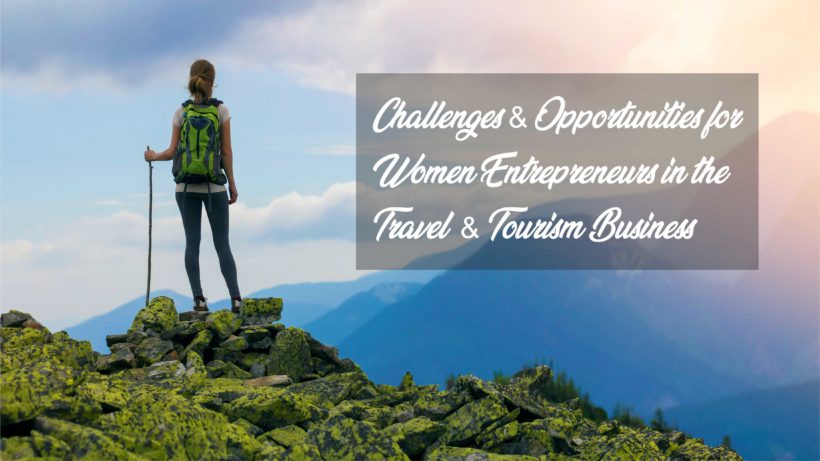On this World Tourism Day (September 27), the COVID-19 pandemic opens up an opportunity – to reimagine the future of the tourism sector
The travel and leisure industry has evolved to become one of the fastest-growing sectors around the globe. According to the World Travel & Tourism Council, it generates around 10% of the global GDP. And, by boosting women’s equality as per McKinsey Global Institute Report – it could add 12 trillion dollars to global growth by 2025.
In India too, the scope seems very positive. If concrete steps are taken to address gender inequality at work and in society, it can lead to 18% higher gross domestic product for India by 2025. Indian tourism sector has the prospective to drive economic growth (with its 9.6% contribution to India’s GDP in 2016-17), and it also has the power not only to elevate women out of below-poverty-line but also provide dignified sustainable employment.
A positive trend noticed was that women entrepreneurship in the travel and tourism space has revealed an upward path. Certain factors have propelled this – like government support, stepping up women education, the surging desire for economic independence and so on. On the other hand, going by the performance of women entrepreneurs in terms of profits, market share, contribution, sustainability – it has not been very encouraging. And, because of the lack of empowerment, confidence, gender-centric factors, lack of internal/external support and cooperation, women entrepreneurs are not confident about their performance.
One could say, tourism is suitable for women. Rightly so, we have seen women entrepreneurs have proliferated in tourism industry in roles such as – travel agents, tour operators, founders of tourism enterprises and hotels. Interestingly, around 70% of the travel industry involves women.
Challenges faced by women entrepreneurs
For the tourism industry to preserve its dynamic model in terms of wealth creation and employment, it is essential to take some measures – to guarantee quality services and continue to improve people’s lives. To achieve this goal, it is necessary to identify the challenges that the sector is facing and most importantly, what tourism businesses must do to overcome them.
Some of the challenges are – non-availability of finance, pressure of domestic responsibilities, stiff competition, problems pertaining to expansion/diversification, less scope for diversification, requirement for professional expertise, lack of guidance, direction and government support, seasonal nature of employment, lack of reliable and fixed income, definite compulsion to earn profits within short span, and lack of mobility. To add to these is the current uncertain business environment.
What is the road ahead?
Tourism has been a vehicle for integration, empowerment and income generation especially when you look at women, rural communities, and other historically marginalized population. Tourism is also a key pillar for the conservation of natural and cultural heritage.
What is the road ahead? It must be in a way that is safe, equitable and climate-friendly. Supporting people whose livelihood depends on tourism means building a sustainable and responsible travel experience that is safe for host communities, workers and travellers.
So, the road to recovery should focus on five priority areas – how to mitigate the socio-economic impact of the crisis, build resilience across the entire tourism value chain, maximize the use of technology in the tourism sector, promote sustainability, going ‘green’ & foster partnerships to enable tourism to further support the Sustainable Development Goals.
Predominantly 2020 has been designated as the ‘Year of Tourism and Rural Development’ by UN World Tourism Organization (UNWTO), and the thematic idea is – to promote tourism as a sector for creating ample amount of jobs and opportunities as well as to uplift rural development.
New trends emerging
The business sector is disrupting and new trends are emerging. Entrepreneurs need to keep their finger on the pulse. New elements are capturing the market. New destinations, new technologies and means of transport have caused major shifts in the industry. Early adoption of new trends is vital, and it is important to follow the current tourism trends in response to consumer behaviour, after the coronavirus pandemic. What are some opportunities that can steer your business in the right direction? Domestic travel may become a trend and new concepts like ‘staycations’, short trips are emerging which may revive the industry.
Relevance of tourism & rural development
As the global tourism sector faces up to the COVID-19 pandemic, ‘tourism and rural development’ is more relevant than ever. Tourism in rural areas offers important opportunities for recovery, making it critical to support rural communities facing the economic and social impacts of the pandemic.
Focusing on the rural-class economy UNWTO observes that with high skills and significant educational facilities, youth migration to other countries has left rural economy deprived of well-educated people and proper focus.
UNWTO has highlighted some important facts. Economic returns from agriculture are diminishing in many areas. Simultaneously, climate change is a threat to traditional way of life. Under these circumstances, travellers’ demand for new experiences around nature, local culture and products, as well as community engagement, offer immense opportunities for economic revitalization.
The creation of value through tourism needs to be approached from an all-round perspective that engages all other sectors and activities in the tourism value chain. National policies and programmes such as the ‘Magical Towns’ of Mexico are a good example of how rural communities can benefit from tourism.
Women empowerment through tourism
Even in many poor countries, there exists a thriving tourism business. Apart from a unique ability to boost equality across the world, tourism also is a meeting point. With its major plus point that its workforce is majorly, female, tourism opens up an opportunity for women – to pull them out of poverty, equip them with skills and provide dignified, sustainable employment. So, the tourism industry unleashes a huge potential.
But as the UN World Tourism Organization’s (UNWTO) report revealed, the details behind the statistics are not quite so equal. Majority of these women are concentrated in lower-level jobs like cooking, cleaning, serving and clerical work, and for these roles they are paid on average 10 to 15 percent less than male staff. In addition, many undertake unpaid roles within tourism – supporting family businesses as invisible customer service providers, chambermaids, PAs and so on.
Impact of COVID-19 on tourism
Unfortunately, tourism has been hit hard by the COVID-19 pandemic. Following the lockdown, restrictions on travel and a sudden drop in consumer demand have led to an unprecedented drop in international tourism, which in turn have led to economic loss and the loss of jobs. Statistics are rather depressing. Data from the UN World Tourism Organization (UNWTO) shows that 100 to 120 million direct tourism jobs are at risk. The UN Conference on Trade and Development (UNCTAD) forecasts a loss of 1.5 to 2.8 per cent of global GDP.
So, on this World Tourism Day, the COVID-19 pandemic opens up an opportunity – to reimagine the future of the tourism sector. The focus should be on how it contributes to the sustainable development goals, through its social, cultural, political, and economic value. The ray of hope is that – tourism can eventually help us move beyond the pandemic, by bringing people together and promoting solidarity and trust, which are very crucial ingredients in advancing global cooperation, that is imperative today.










